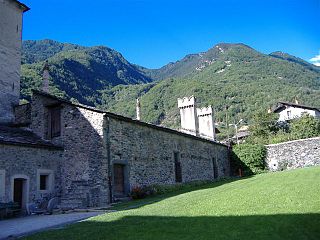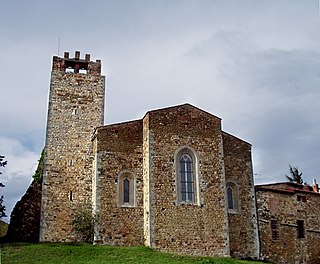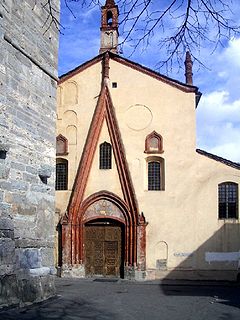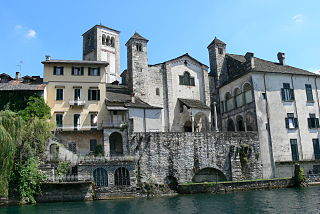
Montalcino is a hill town and comune in the province of Siena, Tuscany, central Italy.

San Gimignano is a small walled medieval hill town in the province of Siena, Tuscany, north-central Italy. Known as the Town of Fine Towers, San Gimignano is famous for its medieval architecture, unique in the preservation of about a dozen of its tower houses, which, with its hilltop setting and encircling walls, form "an unforgettable skyline". Within the walls, the well-preserved buildings include notable examples of both Romanesque and Gothic architecture, with outstanding examples of secular buildings as well as churches. The Palazzo Comunale, the Collegiate Church and Church of Sant' Agostino contain frescos, including cycles dating from the 14th and 15th centuries. The "Historic Centre of San Gimignano" is a UNESCO World Heritage Site. The town also is known for saffron, the Golden Ham, and its white wine, Vernaccia di San Gimignano, produced from the ancient variety of Vernaccia grape which is grown on the sandstone hillsides of the area.

Bobbio is a small town and commune in the province of Piacenza in Emilia-Romagna, northern Italy. It is located in the Trebbia River valley southwest of the town Piacenza. There is also an abbey and a diocese of the same name. Bobbio is the administrative center of the Unione Montana Valli Trebbia e Luretta.

Aosta is the principal city of Aosta Valley, a bilingual region in the Italian Alps, 110 km (68 mi) north-northwest of Turin. It is situated near the Italian entrance of the Mont Blanc Tunnel, at the confluence of the Buthier and the Dora Baltea, and at the junction of the Great and Little St Bernard Pass routes.

The term Norman architecture is used to categorise styles of Romanesque architecture developed by the Normans in the various lands under their dominion or influence in the 11th and 12th centuries. In particular the term is traditionally used for English Romanesque architecture. The Normans introduced large numbers of castles and fortifications including Norman keeps, and at the same time monasteries, abbeys, churches and cathedrals, in a style characterised by the usual Romanesque rounded arches and especially massive proportions compared to other regional variations of the style.

Brusson is a town and comune in Val d'Ayas, a left minor valley of the Aosta Valley region in Italy.

Fénis Castle is an Italian medieval castle located in the town of Fénis. It is one of the most famous castles in Aosta Valley, and for its architecture and its many towers and battlemented walls has become one of the major tourist attractions of the region.

Ayas is a comune sparso in the Aosta Valley region of northwestern Italy, with 1359 inhabitants in 2010.

Montjovet is a town and comune in the Aosta Valley region of north-western Italy. Montjovet lies in the lower Aosta Valley, between France and Switzerland. Though it only has an area of 18.7 square kilometers, the commune has 50 villages and hamlets, and a number of hills, the highest of which is Mont Lyan, at 2174 metres. Historically, the parish was under the control of the Bishop of Aosta. The current main parish church, Parrocchia della Natività della Vergine Maria, opened in 1837.

Issogne Castle is a castle in Issogne, in lower Aosta Valley, in northwestern Italy. It is one of the most famous manors of the region, and is located on the right bank of the Dora Baltea at the centre of the inhabited area of Issogne. As a seigniorial residence of the Renaissance, the Castle has quite a different look from that of the austere Verrès Castle, which is located in Verrès, on the opposite bank of the river.

Campagnatico is a comune (municipality) in the Province of Grosseto in the Italian region Tuscany, located about 100 kilometres (62 mi) south of Florence and about 20 kilometres (12 mi) northeast of Grosseto in the valley of the Ombrone River.

The Collegiate church of Saint Ursus is a collegiate church in Aosta, northern Italy, dedicated to Saint Ursus of Aosta.

Verrès Castle is a fortified 14th-century castle in Verrès, in the lower Aosta Valley, in north-western Italy. It has been called one of the most impressive buildings from the Middle Ages in the area. Built as a military fortress by Yblet de Challant in the fourteenth century, it was one of the first examples of a castle constructed as a single structure rather than as a series of buildings enclosed in a circuit wall.
The castle stands on a rocky promontory on the opposite side of the Dora Baltea from Issogne Castle. The castle dominates the town of Verrès and the access to the Val d'Ayas. From the outside it looks like an austere cube, thirty metres long on each side and practically free of decorative elements.
Aymon II of Challant was a nobleman of the Challant family of Aosta Valley.
Ebal I of Challant was a nobleman of the Challant family of Aosta Valley.

Romanesque architecture is an architectural style of medieval Europe characterised by semi-circular arches. The term "Romanesque" is usually used for the period from the 10th to the 12th century with "Pre-Romanesque" and "First Romanesque" being applied to earlier buildings with Romanesque characteristics. Romanesque architecture can be found across the continent, diversified by regional materials and characteristics, but with an overall consistency that makes it the first pan-European architectural style since Imperial Roman Architecture. The Romanesque style in England is traditionally referred to as Norman architecture.

Sarriod de la Tour Castle is a castle in the town of Saint-Pierre by the Dora Baltea River, in Northwestern Italy's Aosta Valley. The original castle was typical of the style built between the 10th and 12th centuries, and was greatly expanded by Jean Sarriod in 1420 and his son, Antoine, in 1478. The north wing's ground floor features a wooden-ceilinged "Hall of Heads", named for its decorative motifs.

The Basilica di San Giulio is a Roman Catholic church on the small Isola San Giulio in the center of Lake Orta, province of Novara, north-western Italy. It has the status of a minor basilica. Although the island is part of the Orta San Giulio municipality, the basilica belongs to the San Giacomo parish, including the island and a portion of the west coast of the lake in San Maurizio d'Opaglio municipality.

The Palasinaz Lakes are a group of lakes located in the Italian Alps, in the Aosta Valley region of northern Italy. They are of glacial origin and are situated in the southern foothills of the Monte Rosa group and are accessible from the villages of Brusson and Champoluc. The group is composed of the following lakes: the Lac Long, the Lago Pocia, the Lac du Couloir, the Lac Vert, and, the Lago della Battaglia.

















